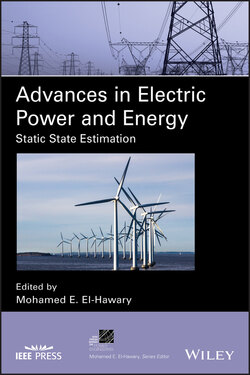Читать книгу Advances in Electric Power and Energy - Группа авторов - Страница 69
2.5.8 Formulation Overview
ОглавлениеTable 2.7 provides a general overview of the computational requirements needed to formulate the considered estimators as mathematical programming problems. This table contains the following information:
The first column indicates the estimation techniques considered.
The second and third columns indicate whether or not a large parameter M and/or a predefined tolerance T is required.
The fourth and fifth columns show the number of continuous/binary optimization variables.
The sixth column indicates the number of additional constraints required.
Finally, the seventh column denotes the nature of the resulting mathematical programming problem.
TABLE 2.7 Characterization of different state‐estimation formulations.
| Parameter M | Tolerance T | Continuous variables | Binary variables | Additional constraints | Problem type | |
|---|---|---|---|---|---|---|
| WLS | ✗ | ✗ | n | — | 0 | NLP |
| LAV | ✗ | ✗ | n + m | — | 2m | NLP |
| QC | ✗ | ✓ | n | m | 0 | MINLP |
| QL | ✗ | ✓ | n + m | m | 2m | MINLP |
| LMS | ✓ | ✗ | n + 1 | m | 2m + 1 | MINLP |
| LTS | ✓ | ✗ | n + m | m | 2m + 1 | MINLP |
| LMR | ✓ | ✓ | n | m | 2m | MINLP |
The acronyms NLP and MINLP represent nonlinear problem and mixed integer nonlinear problem, respectively. The symbol ✓ indicates “needed,” while the symbol ✗ indicates “not needed.”
Figure 2.7 provides a graphical comparison between methods in terms of number of continuous/binary variables and quantity of additional constraints.
Figure 2.7 Problem size comparison for different estimators.
In Figure 2.7, observe that the LMS and LTS estimators require the highest number of both continuous/binary variables and additional constraints. The computational burden of these algorithms is thus expected to be heavier than that of the others.
